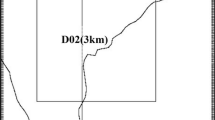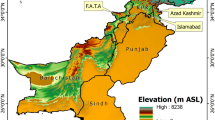Abstract
Hot winds are the marked feature of summer season in India during late spring preceding the climatological onset of the monsoon season in June. Some years the conditions becomes very vulnerable with the maximum temperature (T max) exceeding 45 °C for many days over parts of north-western, eastern coastal states of India and Indo-Gangetic plain. During summer of 2015 (late May to early June) eastern coastal states, central and northwestern parts of India experienced severe heat wave conditions leading to loss of thousands of human life in extreme high temperature conditions. It is not only the loss of human life but also the animals and birds were very vulnerable to this extreme heat wave conditions. In this study, an attempt is made to assess the performance of real time extended range forecast (forecast up to 3 weeks) of this scorching T max based on the NCEP’s Climate Forecast System (CFS) latest version coupled model (CFSv2). The heat wave condition was very severe during the week from 22 to 28 May with subsequent week from 29 May to 4 June also witnessed high T max over many parts of central India including eastern coastal states of India. The 8 ensemble members of operational CFSv2 model are used once in a week to prepare the weekly bias corrected deterministic (ensemble mean) T max forecast for 3 weeks valid from Friday to Thursday coinciding with the heat wave periods of 2015. Using the 8 ensemble members separately and the CFSv2 corresponding hindcast climatology the probability of above and below normal T max is also prepared for the same 3 weeks. The real time deterministic and probabilistic forecasts did indicate impending heat wave over many parts of India during late May and early June of 2015 associated with strong northwesterly wind over main land mass of India, delaying the sea breeze, leading to heat waves over eastern coastal regions of India. Thus, the capability of coupled model in providing early warning of such killer heat wave can be very useful to the disaster managers to take appropriate actions to minimize the loss of life and property due to such high T max.













Similar content being viewed by others
References
Bedekar VC, Dekate MV, Banerjee AK (1974) Heat and cold waves in India. Forecasting manual, India Meteorological Department, Pune. FMU Rep IV-6:1–63
Bhadram CVV, Amatya BVS, Pant GB (2005) Heat waves over Andhra Pradesh: a case study of summer 2003. Mausam 56:385–394
Coumou D, Rahmstorf S (2012) A decade of weather extremes. Nat ClimChange 2:491–496. doi:10.1038/NCLIMATE1452
Dash SK, Mamgain A. (2011) Changes in the frequency of different categories of temperature extremes in India. J Appl Meteor Climatology 50:1842–1858. doi:10.1175/2011JAMC2687.1, http://dx.doi.org/
De US, Arun Singh, Pandey SN (2005) Heat and cold waves affecting India during recent decades. Int J Meteorol 30:323–331
Easterling DR, Meehl GA, Parmesan C, Changnon SA, Karl TR, Mearns LO (2000) Climate Extremes: observations, Modeling, and Impacts. Science 289:2068–2074
Ek M, Mitchell KE, Lin Y, Rogers E, Grunmann P, Koren V, Gayno G, Tarpley JD (2003) Implementation of Noah land-surface model advances in the NCEP operational mesoscale Eta model. J Geophys Res 108(D22):8851. doi:10.1029/2002JD003296
India Meteorological Department (2015a) Annual climate summary, 2014: National Climate Centre, Office of ADGM(R). IMD, Pune, pp 1–24
India Meteorological Department (IMD) (2015b) Monthly climate summary, May 2015: National Climate Centre, Office of ADGM(R). IMD, Pune, pp 1–24
IPCC (2007) Summary for Policy-makers, Climate Change 2007: Mitigation, Contribution of Working Group III to the Fourth Assessment Report of the IPCC. In B. Metz, O.R. Davidson, P.R. Bosch, R. Dave, L.A. Meyer eds. Cambridge University Press, Cambridge, United Kingdom and New York, NY, USA
Jones PD, Briffa KR (1992) Global surface temperature variations during the twentieth century. Part 1, spatial temporal and seasonal details. The Holocene 2:65–79
Kalsi SR, Pareek RS (2001) Hottest April of the 20th century over north-west and central India. Curr Sci 80(7):867–873
Kothawale DR, Rupa Kumar K (2005) On the recent changes in surface temperature trends over India. Geophy. Res. Let. 32:L18714. doi:10.1029/2005GL023528
Krishnan R, Sundaram S, Swapna P, Kumar V, Ayantika DC, Mujumdar M (2010) Crucial Role of Ocean-Atmosphere Coupling on the Indian Monsoon Response during Dipole Events. Clim Dyn 37(1–2):1–17. doi:10.1007/s00382-010-0830-2
Larsen J (2003) Record heat wave in Europe takes 35, 000 lives. Earth policy institute. Story posted on 9 October 2003 [http://www.earth-policy.org]
Mahapatra M, Daastidar SK, Gupta DC (2001) Some aspects of recent heat waves over India. India Meteorological Society, Tropmet Proceeding, pp 189–195
Meehl GA, Tebaldi C (2004) More intense, more frequent, and longer lasting HWs in the 21st Century. Science 305:994–997
Mitchell KE, Wei H, Lu S, Gayno G, Meng J (2005) NCEP implements major upgrade to its medium-range global forecast system, including land-surface component. GEWEX newsletter
Pai DS, Nair Smitha Anil, Ramatathan AN (2013) Long term climatology and trends of heat waves over India during the recent 50 years (1961–2010). Mausam 64:585–604
Palmer TN (1994) Chaos and predictability in forecasting the monsoon. Proc Indian National Science Academy 60:57–66
Palmer TN, Branković C, Richardson DS (2000) A Probability and decision-model analysis of PROVOST seasonal multi-model ensemble integrations. Q J R Meteorol Soc 126:2013–2033. doi:10.1256/smsqj.56702
Parker DE, Jones PD, Folland CK, Bevan A (1994) Interdecadal changes of surface temperature since the late nineteenth century. J Geophys Res 99(D7):373–399
Pattanaik DR (2014a) Operational extended range forecast activity in IMD and its applications in different sectors. Bulletins of Indian Meteorological Society (IMS). Vayu Mandal 40:44–70
Pattanaik DR (2014b) Meteorological subdivisional-level extended range forecast over India during southwest monsoon 2012. Meteorol Atmos Phys. doi:10.1007/s00703-014-0308-6
Pattanaik DR, Hatwar HR (2006) Analysis and impact of delayed onset of monsoon over Northeast India during 2005. Vayu Mandal 32:3–9
Pattanaik DR, Kumar Arun (2014) Comparison of intra-seasonal forecast of Indian summer monsoon between two versions of NCEP coupled models. Theoretical Applied Climatology 118:331–345. doi:10.1007/s00704-013-1071-1
Pattanaik DR and Mukhopadhyay B (2012), Indian Climatology in the context of human health. In: Dogra N, Srivastava S (eds) Climate change and disease dynamics in India. TERI press, New Delhi, p 71–110 (ISBN: 9788179934128)
Pattanaik DR, Gajendra Kumar, Bhatla R, Soni VK, Sanjay Bist, Bhan SC, Mukhopadhyay B (2013a) Heat index outlooks over the Indian region using general circulation model outputs. IMS Bull (Vayu Mandal) 39:12–24
Pattanaik DR, Rathore LS, Arun Kumar (2013b) Observed and forecasted intraseasonal activity of Southwest monsoon rainfall over India during 2010, 2011 and 2012. Pure Appl Geophys 170:2305–2328
Perkins SE, Alexander LV, Nairn JR (2012) Increasing frequency, intensity and duration of observed global heat waves and warm spells. Geophys Res Lett 39:L20714. doi:10.1029/2012GL053361
Raghvan K (1966) A climatological study of severe heat waves in India. Mausam 174:581–586 (formerly Indian Journal of Meteorology & Geophysics)
Rao VUM (2012) Impacts of climate change on Indian Agriculture. (http://www.cseindia.org/userfiles/VUM-CSE-Delhi-16-11-12.pdf. Accessed 6 July, 2015)
Ratnam JV, Behera SK, Ratna SB, Rajeevan M, Yamagata T (2016) Anatomy of Indian heatwaves. Sci Rep. doi:10.1038/srep24395
Richardson DS (2001) Ensembles using multiple models and analyses. Q J R Meteorol Soc 127:1847–1864
Saha S, Coauthors (2010) The NCEP climate forecast system reanalysis. Bull Am Meteorol Soc 91:1015–1057
Sahai AK, Sharmila S, Abhilash S, Chattopadhyay R, Borah N, Krishna RPM, Joseph S, Roxy M, De S, Pattnaik S, Pillai PA (2013) Simulation and extended range prediction of monsoon intraseasonal oscillations in NCEP CFS/GFS version 2 framework. Curr Sci 104:1394–1408
Srivastava AK, Rajeevan M, Kshirsagar SR (2008) Development of a high resolution daily gridded temperature data set (1969–2005) for the Indian region. NCC Research Report No. 8: National Climate Centre, India Meteorological Department, Pune, p 1–15
Suranjana Saha, Moorthi Shrinivas, Xingren Wu, Wang Jiande, Nadiga Sudhir, Tripp Patrick, Behringer David, Hou Yu-Tai, Chuang Hui-ya, Iredell Mark, Ek Michael, Meng Jesse, Yang Rongqian, van den Dool Huug, Zhang Qin, Wang Wanqiu, Chen Mingyue (2014) The NCEP climate forecast system version 2. J Clim 27:2185–2208. doi:10.1175/JCLI-D-12-00823.1
Tyagi A, Pattanaik DR (2012) Real time extended range forecast activities in IMD—performance assessments and future prospects. IMD Met. Monograph No. ERF 01/2012, p 1–132
Acknowledgments
The first author is very much thankful to the Director General of Meteorology, and Deputy Director General of Meteorology (NWP), India Meteorological Department (IMD) for providing all facility to carry out this work. Thanks are also due to NCEP, CPC for providing real time and hindcast data based on Climate Forecast System, Coupled model version-2. Thanks are also due to the office of ADGM (Research), IMD Pune and office of DDGM (WF) IMD Pune for providing gridded and station level T max data over the Indian region for the present study. Special thanks to the anonymous reviewers for the useful comments, which helped us to improve the quality of the paper.
Author information
Authors and Affiliations
Corresponding author
Additional information
Responsible Editor: A. P. Dimri.
Rights and permissions
About this article
Cite this article
Pattanaik, D.R., Mohapatra, M., Srivastava, A.K. et al. Heat wave over India during summer 2015: an assessment of real time extended range forecast. Meteorol Atmos Phys 129, 375–393 (2017). https://doi.org/10.1007/s00703-016-0469-6
Received:
Accepted:
Published:
Issue Date:
DOI: https://doi.org/10.1007/s00703-016-0469-6




